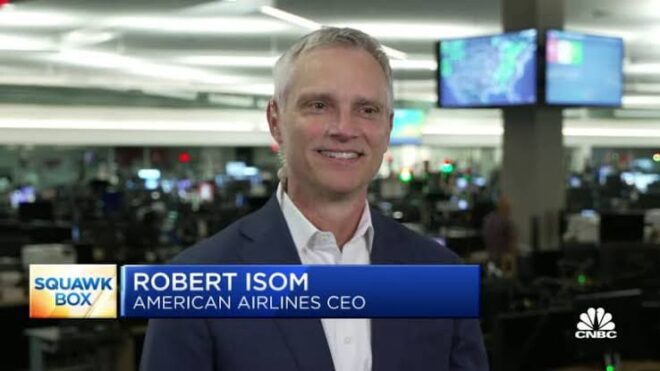
Imagine running a business. (Maybe you don’t have to imagine.)
Now imagine you have two or three main competitors, and your products are very similar. Unless one of you gets really smart or lucky, a lot of your costs and the prices for which you can sell are similar, too.
If you make even the smallest little change that pays off, it’s almost guaranteed that your competitors will copy it quickly.
If you suddenly face a big spike in costs — maybe an increase in cost of goods sold, or a complicated new regulation, or a scarcer market for employees — your competitors will face the same new challenge at nearly the same time.
With that, let’s talk about the big announcement American Airlines made last week: After its rival Delta Air Lines reached an agreement with its pilots that includes very big raises, American Airlines says it’s willing to pay the same high rates.

“Let me be clear,” American Airlines CEO Robert Isom said in a video message to American Airlines pilots (American Airlines provided me with a transcript). “American is prepared to match Delta pay rates and provide American’s pilots with the same profit-sharing formula as Delta’s pilots.”
It’s the sheer amount of money involved that makes this so notable. According to Isom, if the deal goes through, American Airlines pilots would get:
an average of 21 percent raises in the first contract year.
an average 40 percent total pay increase for pilots by the fourth year.
“a much richer profit-sharing program” that would increase the payout pool from 5 percent of pre-tax earnings to 10 percent, and up to 20 percent of earnings above $2.5 billion.
“[A] bump in the company’s annual contribution to… 401(k) plans.”
Ultimately, the best-paid pilots at American Airlines would make a total of $590,000 per year in salary and 401(k) contributions, which works out to “$170,000 more a year than they earn today,” Isom said.
Just like that, the market rate for top airline pilots everywhere just went up significantly. No matter who they work for, pilots have to be happy with that development.
Three other notes worth mentioning:
First, United Airlines is also in the middle of contract negotiations with its pilots, and the increasing pay at its rivals can’t help but have an effect. (“Our pay rates are going to always be — vary depending on the timing of contracts, but always basically going to be at the top of the industry,” United Airlines CEO Scott Kirby said during an earnings call in January.)
Second, even after Isom made this statement to American Airlines pilots, their union this week voted to authorize a strike (although that’s just the first step in a lengthy process, and one that had already been in the works).
Finally, the Delta deal reportedly includes a provision that says if American or United gives its pilots a better deal than Delta’s pilots get, then Delta pilots get that pay matched, plus 1 percent. So it’s possible there’s even another chapter to unfold.
The overall financial calculus is fascinating. The airline news site One Mile at a Time theorizes that Delta is in the best position to absorb higher pilot salaries because they have higher revenue per seat than some rivals, and also because they don’t fly as many long-haul flights that actually require more than two pilot.
Regardless, I think the lessons here are insightful and unexpected.
Nothing happens in a vacuum, and even though we might usually think of employers and employees as usual having a competitive or even rivalrous relationship when it comes to compensation, there’s another dynamic worth considering.
In short, paying your best people more doesn’t just mean you’re more likely to get better qualified applicants and employees.
It might also mean there’s an underappreciated strategic advantage: forcing your competitors to bear the same increased costs.
If they aren’t as prepared as you are to accommodate or afford them, they might have to cut back somewhere else: maybe marketing, or product quality, or the sheer size of their operation.
Maybe they simply have a less profitable business.